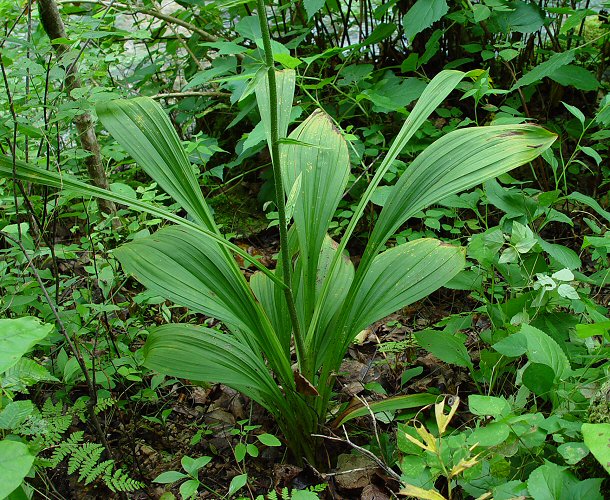Veratrum woodii J.W. Robbins ex Alph. Wood
False Hellebore

Native
CC = 8
CW = 5
MOC = 41
© DETenaglia
Veratrum woodii J.W. Robbins ex Alph. WoodFalse Hellebore | |
 |
Native CC = 8 CW = 5 MOC = 41 |
© DETenaglia |
|
Family - Liliaceae Habit - Perennial forb, with small bulbs and short, stout rhizomes. No allium odor.
Stem - Aerial stems erect or nearly so, to 1.8 m, unbranched below the inflorescence, pubescent with minute, curly hairs.
Leaves - Predominantly basal, those on the aerial stems alternate, linear, greatly reduced, and bractlike. Basal leaves 30-50 cm long, elliptic to broadly oblanceolate, flat or somewhat corrugated, with conspicuous parallel venation, glabrous.
Inflorescences - Panicles of numerous flowers at the tips of the aerial stems, the lower branches with functionally staminate flowers, the remainder with mostly functionally pistillate or perfect flowers. Flowers with stalks 2-6 mm long, subtended by small bracts, none replaced by bulblets.
Flowers - Perianth 6-9 mm long, the sepals and petals free, oblanceolate, lacking a stalklike base and glands, but sometimes pubescent with minute, curly hairs on the upper (inner) surface when young, maroon to purplish brown, turning dark purplish green after flowering. Stamens 6, fused to the base of the perianth. Styles 3, each with a small stigma. Ovary superior, with 3 locules, each with 4-10 ovules.
Fruits - Deeply 3-lobed capsules, 18-25 mm long, ovoid, the lobes beaked with the persistent styles. Seeds winged.
Flowering - July - September. Habitat - Mesic forests, often on north- or east-facing lower slopes. Origin - Native to the U.S. Lookalikes - Vegetative rosettes are somewhat similar to those of Frasera. Other info. - This interesting plant is reasonably common in the eastern half of Missouri. Although its native range extends into several other states to our south and east, it is considered uncommon in every state but Missouri. With a little practice it is easy to distinguish the vegetative rosettes, which is the most common condition in which the plant is encountered. When flowering it is unmistakable, with large inflorescences of numerous deep reddish-brown flowers. Since the flowers are not brightly colored and do not stand out visually from the deep shade in which the plant typically grows, it is often missed. This species is an indicator of rich, undisturbed forest slopes and will rarely if ever be found in disturbed areas. Photographs taken near Pultite Spring, Shannon County, MO., 7-23-04 (DETenaglia); also at Shaw Nature Reserve, Franklin County, MO, 07-22-2011, and Johnson's Shut-Ins State Park, Reynolds County, MO, 07-29-2013 and 08-20-2013 (SRTurner). |